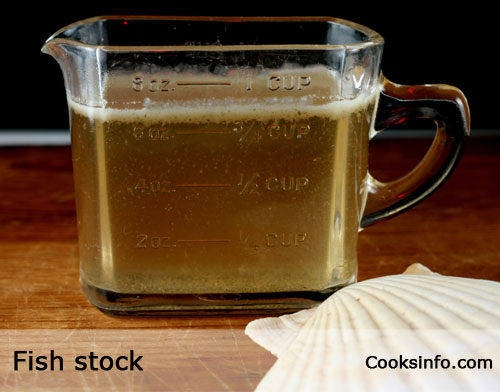
© Randal Oulton
Fish Stock is a little harder to come by than beef or chicken stock. It’s even harder to cheat — while every food store will carry beef, chicken and veg stock cubes, you won’t see fish stock cubes everywhere. They used not to be very good, but have improved in recent years.
The classic ingredients for a fish stock used to be fish heads and bones. You can still get these if you live near a proper fish shop or a market, but most of us get our fish now from supermarkets, where it is all sold nicely filleted and sliced with nary a head to be seen. And supermarkets are where we, for the most part, do our shopping these days.
Fish stocks take very little work, but we just don’t have fish heads floating around in stores these days. Yes, you could buy a whole fish, head on, but many people either don’t want that much fish, or don’t like it with the head on (or really just wanted one small cup of fish stock for a recipe.)
Here are four easier ways to get a fish stock:
- Experiment with fish stock cubes to find a brand you like.
- Buy a fillet or steak of fish, poach it in water, eat the fish or freeze for use in another recipe, and then use the water as your fish stock. Mackerel does not make good stock, as it is quite oily and very strong tasty. Salmon and bluefin are a bit tricky, too, as they have such distinct tastes that their hearty-tasting stocks won’t be for every recipe. Milder fishes such as hake, red mullet, haddock, whiting, sole, gurnard, pollock, flounder, weever or snapper are good to use for general purposes.
- If you happen to be shelling your shrimp before cooking them (don’t do this if you are barbequing them), simmer the shells in some water for about 20 minutes for a lovely shrimp stock.
- Improvise a fish stock using a bottle of clam juice. See recipe for “Fish Stock à l’improviste.”
If you happen to get hold of some fish heads or skeletons, wash them thoroughly first before using. Bring to the boil in enough water to cover, skim off any scum, then lower heat and simmer them for about 20 minutes, along with a bay leaf, a peppercorn or two, and a bit of salt.
Any stock you make from fish — whether bones, heads, fillets or steaks — needs to be strained very carefully to ensure that no fine fish bones end up in your final stock.
And remember, fish stocks cook far faster than do stocks for chicken, beef or meats in general. Simmer for no more than 20 minutes, or it may go bitter.

